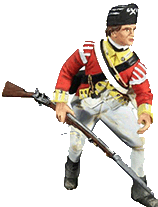 During the 1770's, a typical British Infantry Regiment consisted of the Field and Staff Officers and 10 companies, composed of three different types of soldiers: eight Battalion or "Hat" Companies, one Company of Grenadiers, and one Company of Light Infantry. Each of these companies had a specific role in the regiment and were typically manned as follows:
During the 1770's, a typical British Infantry Regiment consisted of the Field and Staff Officers and 10 companies, composed of three different types of soldiers: eight Battalion or "Hat" Companies, one Company of Grenadiers, and one Company of Light Infantry. Each of these companies had a specific role in the regiment and were typically manned as follows:
 Field and Staff Officers:
Field and Staff Officers:
Lieutenant Colonel (the Officer Commanding), Major (Second in Command), Adjutant, Quartermaster, Chaplain, Surgeon and Surgeon's Mate.
Grenadier Company (49 Officers and men):
Captain, 2 Lieutenants, 2 Serjeants, 3 Corporals, 1 Drummer, 2 Fifers, 38 Private Soldiers.
Light Infantry Company (47 Officers and men):
Captain, 2 Lieutenants, 2 Serjeants, 3 Corporals, 1 Drummer, 38 Private Soldiers.
Eight Battalion Companies (47 Officers and men each):
Captain (or Captain-Lieutenant in the Colonel's, Lt. Colonel's, and Major's companies), 2 Lieutenants, 2 Serjeants, 3 Corporals, 1 Drummer, 38 Private Soldiers.
Thus, a Regiment at "full-strength" consisted of approximately 480 Officers, NCOs and Private Soldiers.
What did a soldier get paid?
Before we go into that, one needs to understand the 1700's British monetary system. The basic unit of currency was the pound (£), which consisted of 20 shillings (s). A shilling contained 12 pence (d). Thus, a pound was 240d (pence). The notation 1£ - 7s - 10d (also as 1-7-10) means 1 pound 7 shillings and 10 pence, which comes out to 390d. 7s / 10d (also as 7/10) = 7 shillings and 10 pence.
One pound from the 1770's would be worth ~£4.42 in todays money (note that the English monetary system was decimalized in 1971, the pound being divided into 100 units).
Some other common coinage at the time was:
- Halfpenny (or ha'penny): 1/2 pence
- Farthing = 4 pence
- Crown = 5 shillings
- Guinea = 21 shillings in the 1770's (Originally, a 20 shilling gold coin whose value shifted with the price of gold. It's value was set at 21 shillings in 1717)
So, getting back to the original question, "What was a British soldier paid?" Pay of course was determined by rank and the type of unit. The basic line infantry regiment, such as the Tenth Foot, was paid at the lowest scale, a Guard's unit the highest. Below is the "per day" scale as it would have applied to the Tenth Foot.
- Private: 8d per day (56d per week), however, money was deducted from this pay to cover the cost of the unifrom, room & board, and other accroutrements leaving the soldier with something like 20d per week left over. Note that a common laborer could earn up to 24d per day.
- NCO's
- Corporal: 1s
- Drummer: 1s
- Fifer (Grenadier Co'Y only): 1s
- Serjeant: 1s / 6d
- Company Officers
- Second Lieutenant: 4s
- Captain Lieutenant / Lieutenant: 4s / 8d
- Captain: 10s;
- Staff / Staff Officers
- Sugeon's Mate: 3s / 6d
- Sugeon: 4s
- Chaplain: 3s / 8d
- Quartermaster: 4s / 8d (added to the officers "rank" pay)
- Adjutant: 4s (added to the officers "rank" pay)
- Major & Captain of the Major's Co'Y: 15s
- Lieutenant Colonel & Captain of the Lt. Colonel's Co'Y: 17s
- Colonel & Captain of the Colonel's Co'Y: 1£ - 4s
The Tenth Foot Today
Currently, the Recreated 10th Foot consists of three companies of soldiers: a Company of Grenadiers and a Company of Light Infantry -- these were the companies that took part in the march to Concord in the early morning hours of April 19th, 1775 -- and a Colonel's (Battalion) Company. The Regiment also boasts Drummers & Fifers and a Corps of Civilian Volunteers. Follow the links below to find out more about the role each played in an 18th Century British Regiment.
In addition, as the Tenth Regiment is an IRS recognized 501(c)3 public charity incorporated under the laws of the Commonwealth of Massachusetts, we are guided by a Board of Directors, which consists of members both from within and outside of the Regiment.










